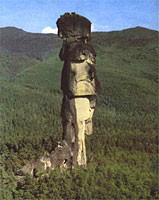Siberia
Siberia is a region in Russia, the
greater part of the Asian territory, which occupies an area larger than
the USA. It stretches to the Ural in the west, the North Pole Sea in
the north, the Siberian highlands and the Pacific watershed mountain
ridges in the east and up to hilly steppes of Kazakhstan and boundary
with Mongolia in the south.
The area is about 10 million square
km. The name “Siberia” came from the Tartar word “Sibi”, that means
“sleeping land”. It splits into the west Siberian lowland, central Siberian
plateau (also mid-Siberian mountains), the North-eastern Siberian mountain
terrain, Kamchatka peninsula, and the south-Siberian highlands (also
Trans-Baikal Region). The west Siberian lowland lies east of the Urals
with vast marshlands through which the great Ob and Enisey rivers flow.
The majority of the rivers of Siberia, including large ones (Ob with
Irtysh, Enisey and Lena), belong to the pools of the seas of Arctic
ocean.
In the natural respect Western Siberia
and Eastern Siberia, within the limits of which West Siberian plain,
Central Siberian plateau, mountains of Southern Siberia, Altai, Western
Sayan mountains, East Sayan mountains, mountains of Tuva, Pribaikalye,
Transbaikalia are located and system of mountain ranges in north-east
of Siberia, framed by the Verhoyansk ridge and Kolyma range, stand out.
The Mid-Siberian mountains cut through
the vast highland region from Enisey to Lena. The eastern part reaches
the Mid-Yakut lowland, and in the north the mountain land drops down
into the Taimyr marshy, to ascend again over the Arctic coastline to
the Byrranga mountain range. The southern border of the Mid-Siberian
mountains is marked by mountain chains, which begin in the most westerly
outpost with the Altai mountains, and follow the Western and Eastern
Sayan and Trans-Baikal mountain landscape.
|

|
North-east of the Eastern Sayan mountains
lies the deepest inland lake in the world (1620m deep), the “Pearl of
Siberia”, Lake Baikal. It takes the area of 32’000km² - it is about
the same size as Belgium. East of Lake Baikal and south of Lena the
East Siberian mountain terrain spans out into more mountain chains and
curves through South-east Siberia to the north-west coast of the Okhotskoe
Sea. The Verhoyansk, Tscherskogo and Kolyma mountains (all over 3000m
high) rise over north Siberia. The most part of Siberia is occupied
with tundra and taiga; in the south - forest-steppe and steppe terrain.
In Siberia the severe extreme continental
climate prevails with long cold winters and short hot summers. Cold
is the determining element in Siberia. Average temperatures of January
is negative 16 °Ñ in the south of
West Siberian plain and reaches up to negative 48 °Ñ
in the east of Yakutia where one of cold poles of Northern hemisphere
is located. However the winter climate feels very pleasant in spite
of low temperatures. Winter in Siberia means high pressure, i.e. a lot
of sunshine and dry air. The summer is clear, sunnier and warmer than
in central Europe.

